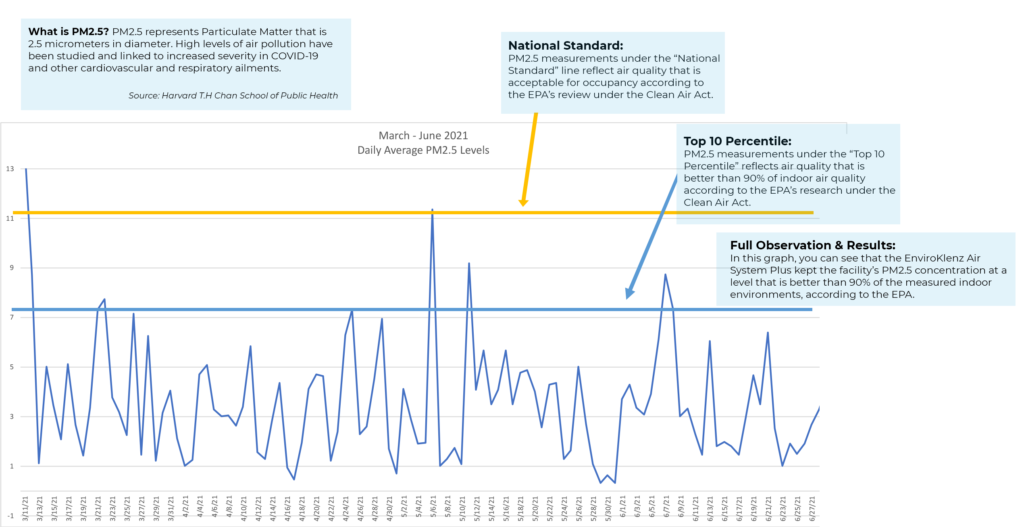EnviroKlenz® in a New Jersey Public Utility Facility
An indoor air quality case study.
Study Background
EnviroKlenz conducted case studies with partners at various facilities in the United States during the COVID-19 pandemic. The EnviroKlenz Air System Plus was deployed and operational alongside an air meter that measures and records particulate matter. The EnviroKlenz Air System utilizes multi-stages of filtration consisting of patented technology for a broad array of contaminates, UVC (254 nm wavelength), and HEPA. The air meter provides real-time estimates of particulate matter concentrations (PM1, PM2.5, PM10) and particle size distribution using a combination of multiple light scattering-based particle sensors.
The systems ran in operational facilities with daily schedules being carried out as usual.
Increases and decreases in the particulate matter were observed as expected given the conditions with the air monitor.
The results from this case study with the EnviroKlenz Air System Plus were compared to particulate matter data from the Environmental Protection Agency (EPA). From 2000-2019, the EPA, through a nationwide network of over 400 monitoring sites, developed ambient air quality trends for PM 2.5 particle pollution, representing fine inhalable particles, with diameters that are generally 2.5 micrometers and smaller. In the EnviroKlenz case studies, a broader range of particles was monitored, all with similar trends, but for illustration purposes, the data collected aligned to the size range of the EPA data is shown by plotting the national standard and the top 10 percentile for air quality for comparison.
Test Details
Testing Period: 12/9/20- Present
Setting: Public Utility Facility
Equipment Used: (1) EnviroKlenz Air System Plus and (1) Quant-AQ commercial-grade aerosol measurement instrument. Readings were captured in the ranges of PM10, PM2.5, and PM1(sub micron sized)
Running Time: The EnviroKlenz Air System Plus is typically only run during school hours.
Monitor status: Kept on throughout testing period
Observation: The daily average PM 2.5 readings show that the EnviroKlenz Air System Plus is able to maintain indoor air quality and remove particles quickly.
At a public utility facility in New Jersey, the EnviroKlenz Air System Plus was deployed to reduce levels of indoor air pollution. The EnviroKlenz Air System helped keep the air quality better than the EPA national standard for 2.5 particulate matter, and much of the time in the top 10 percentile. This illustrates the benefit of supplemental air systems that can capture and mitigate a broad array of environmental contaminants as they enter or are stirred up in the air space without needing to circulate fully out of the room with air exchange.
Comparison to National Average

The average daily readings above show the overall impact of the EnviroKlenz Air System on the indoor air quality of a high-traffic facility. The low PM 2.5 levels indicate air quality that is better than 90% of the measured indoor environments, according to the Environmental Protection Agency.
More Case Studies
Massachusetts Dental College
The EnviroKlenz Air System Plus was deployed at a dental college as a supplement to capture aerosolized matter during procedures. The facility already had excellent air quality, but the systems were deployed to mitigate pathogens that may exist during procedures to prevent them from circulating in the air.
Public School in the Midwest
At a midwestern city urban school, the air systems showed a steady overall decrease in particulate matter over a 2-week period. In this site, the building did have central heating and air that helps steady air quality readings. Increase, or spikes, were observed at higher traffic points of the day when students were more likely to be entering, moving, or leaving the facility.
Iowa School
At an Iowa school, one EnviroKlenz Air System Plus was used per classroom. The air purifiers were shut off during winter break and restarted on 1/14/2021. A steep drop in PM can be seen over the first 48 hours of running the air systems. The air purifiers will typically be run only during class hours.
